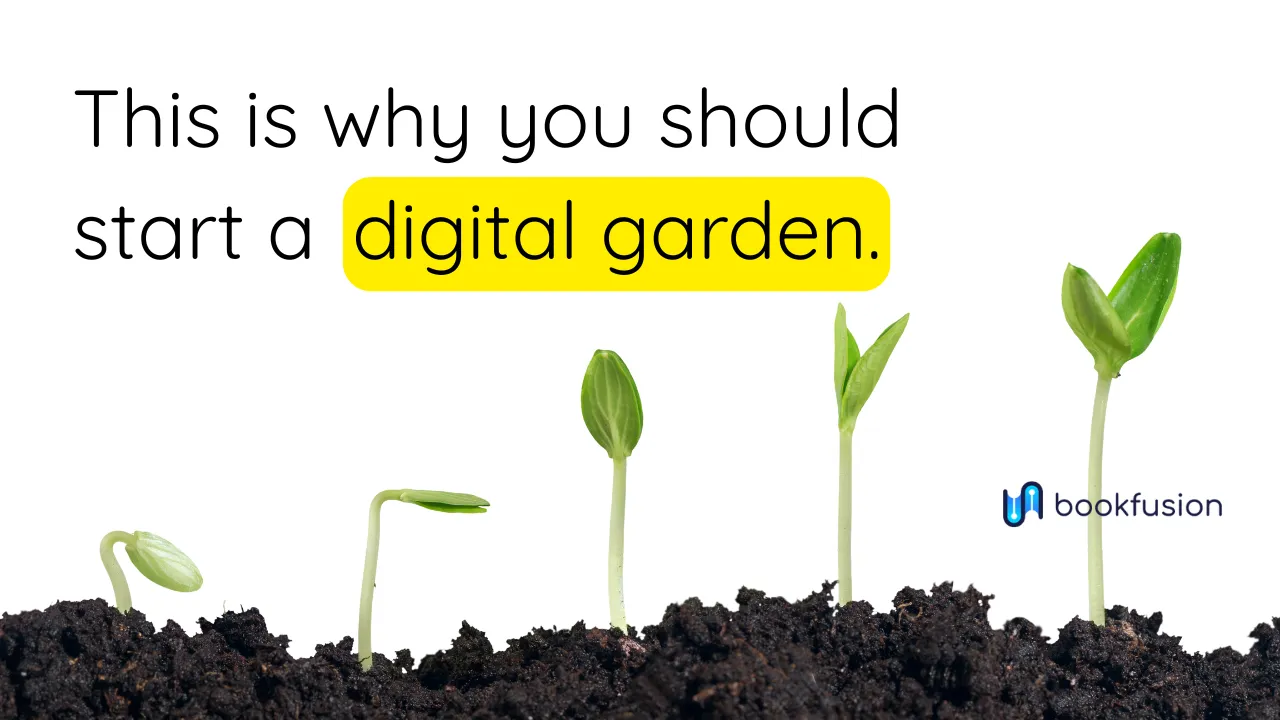What a Digital Garden Can Teach You About Life

There’s a quite movement happening online. As people are continuously bombarded with information from every angle, some have begun to apply their natural instincts to forage for mushrooms, berries and golden nuggets and apply them to their unique lives, the vast information they encounter, and their personal knowledge and experiences. The world is changing fast, and it will be this human element, our creative human ability to make connections that will make all the difference. And that is exactly why it is so important for us to rethink how we capture knowledge, reflect on what we read, and develop our ideas over time.
The Digital Garden
The act of trying to manage your knowledge is not new, and has been a crucial topic to organisations for many years. It is apparent, however, that there is new renaissance going on as the tools to assist knowledge management improve and the case for personal knowledge management grows.
The concept of a Digital Garden similarly can be traced back to the beginning of the web, tumblr blogs and the initial personal websites and blogging habits we all had. Mark Bernstein had talked about this phenomenon and coined the term digital garden then, as early as 1998 in an essay called, “Hypertext Gardens”. But this essay is a bit dated, and instead talks more about users’ experience of hyperlinks, the internet and wikis as opposed to curating personal internet spaces.
Maggie Appleton, a great thinker in today’s space who helped to popularise the term, explains the garden like this:
A [digital] garden is a collection of evolving ideas that aren’t strictly organised by their publication date. They’re inherently exploratory — notes are linked through contextual associations. They aren’t refined or complete — notes are published as half-finished thoughts that will grow and evolve over time. They’re less rigid, less performative, and less perfect than the personal websites we’re used to seeing.
When people think about second-brain building and digital gardens, the conversation tends to be centred around tools and resources. And although that’s a big part of it, the core is your approach: how you acquire, build and share knowledge. A digital garden explores your methods, and shows your thinking inherently. It’s about cultivating your ideas like plants: nurturing them over time, letting them cross-pollinate, and allowing others to wander through.

The Metaphor
Calling it a “garden” isn’t just cute branding — it’s a deep metaphor for how we process knowledge. Traditional note-taking apps have long been designed as digital filing cabinets: linear, folder-based, and optimised for storage. But increasingly, people are turning away from this paradigm in favour of more organic, interconnected systems that are dynamic and grow with time.
- Seeds represent fleeting thoughts, quick highlights, or a sentence that made you pause while reading.
- Sprouts are early connections: a note linking two unrelated ideas, or a question you’re not yet ready to answer.
- Vines start to form as you revisit, refine, and build upon these notes — layering your own interpretations and linking them across themes.
- Blooms might become essays, videos, lectures, or polished articles. But the garden doesn’t need to bloom to be valuable.
The garden gives space for notes to live at every stage of development. It acknowledges that our ideas are never truly finished.
It’s also good to note that not every ‘gardener’ uses these terms specifically, but each digital garden will have some sort of label system that helps its visitors to know what stage the note is in.
Elements of Digital Gardening
Here are common themes and values of digital gardeners, as suggested by Maggie Appleton.

- Topography over Timelines — Digital gardens prioritise spatial and conceptual organisation over chronological order. Instead of presenting content in a linear, time-based sequence, they use interlinked notes that allow for exploratory navigation through ideas.
- Continuous Growth — Content in a digital garden is perpetually evolving. Notes are treated as living documents that are regularly updated and refined, reflecting the ongoing development of thoughts and ideas.
- Imperfection & Learning in Public — Digital gardens embrace the sharing of incomplete or rough ideas. This openness fosters a culture of learning in public, where the process of thinking and development is transparent and collaborative.
- Playful, Personal, and Experimental — Each digital garden is a unique, personal space that encourages experimentation. Gardeners are free to design their gardens in ways that reflect their individual thinking styles and preferences, often using various web technologies creatively.
- Intercropping & Content Diversity — Just as diverse planting leads to a healthier physical garden, incorporating various content types — such as text, images, videos, and code snippets — enriches a digital garden. This diversity caters to different learning styles and keeps the content engaging.
- Independent Ownership — Digital gardeners maintain control over their content by hosting it on platforms they own, rather than relying on social media or third-party services. This independence ensures longevity and flexibility in how the garden evolves over time.
What We Learn from Gardening Online

By moving away from linear, perfection-driven thinking and embracing the mindset of digital gardening, we begin to see knowledge not as something to be hoarded or neatly filed away, but as something to be lived with. Intelligence>Intellect, Connection>Perfection. This shift allows us to break free from the pressure to produce polished work on a deadline and instead invites us to engage more deeply with curiosity, exploration, and long-form thinking. Rather than rushing toward conclusions or “finished products” the way the internet has become, we create space for questions to breathe, for connections to emerge slowly, and for meaning to grow over time.
This mindset also nurtures a greater sense of trust in ourselves and connection with others. When we share in-progress thoughts and imperfect notes, we make visible the often-invisible process of learning and thinking. It cultivates a culture of transparency, where insight is not measured by authority but by the effort, ingenuity and journey. In a digital garden, we’re not just archiving what we know — we’re actively making sense of our world. And that act of sense-making, done openly and organically, can become a quiet form of resistance against the noise, speed, and disposability of the information age.
Starting Your Own Garden (Yes, You Can)
Most of the digital gardening ethos is related to public facing websites and “blogs” but in actuality, anyone can start a garden, you just need the right tools and the right heart. Here’s where you can start:
- Choose tools that support connection— For example, you could use BookFusion to read ebooks and articles and export your highlights & notes to topographical apps like Obsidian, Roam or Tana. That’s where you can practise to link and build notes.
- Link generously — even if the connection feels loose or silly, plant the link. See what grows.
- Revisit often — tend to your notes like plants. Add, trim, evolve.
- Publish if you feel brave — or keep it personal. Either way, you’re nurturing a relationship with your ideas. Obsidian offers a plan where you can stylise and publish your vault. Or, you could build a site from scratch to make it unique to you, the way the existing digital garden creators promote.
Plant Seeds & Let Your Knowledge Grow.
A digital garden is a manifestation of a growth mindset.
It reminds us that learning is a process, not a destination. Your thoughts are worth revisiting and knowledge isn’t just about collecting — it’s about connecting.
So start today. Plant a note. Link an idea. Watch your garden grow.
This message was powered by BookFusion, the best app to read, sync & derive value from your content. If you want to know more, you can check us out, here.


